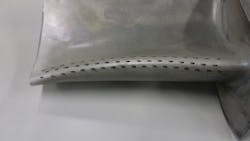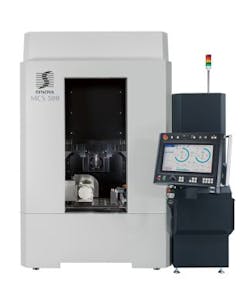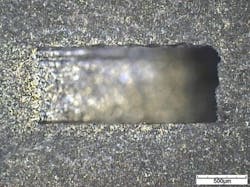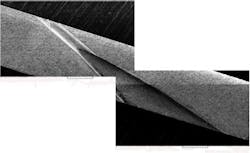Hybrid cell for turbine blade hole drilling
NITIN SHANKAR
The whole is truly greater than the sum of its parts
Electric discharge machining (EDM) and laser are the two proven technologies for drilling precision holes. Each technology has its advantages and limitations. Makino and Synova have developed a hybrid cell, combining both technologies to offer the ideal solution for drilling tapered or funnelled holes in turbine engine components.
HybridCell
Two companies combine laser and EDM technologies to change the way turbine blades are machined, where Synova's patented Laser MicroJet (LMJ) laser and Makino's state-of-the-art EDM hole drilling machine complement each other in machining turbine blades.
Turbine blades are often the limiting component of gas turbines, subjected to enormous centrifugal forces and high temperatures of around 1370°C. These stress levels weaken the blades and make them susceptible to creep failures. To survive in this difficult environment, turbine blades use exotic super-alloys, thermal barrier coatings, and internal cooling air channels.
Metallurgical quality is of importance in turbine blades. With dry laser machining, the crucial characteristics pertain to the recast layer (the re-adhered molten material) and to the heat-affected zone (altered microstructure area of the underlying base material). These factors can impact the operating life cycle of the component. With Synova's patented "wet" laser, these risks are reduced to a minimum.
Ceramic and aluminide thermal barrier coatings (TBCs) on turbine blade parts increase corrosion resistance and temperature capability by about 90°C. These coatings, however, pose problems in EDM machining because of their non-conductive nature. The laser can cut through TBCs without such problems.
The cooling air channels in turbine blades may either be round holes or diffuser holes, featuring tapered or funnel shapes leading to a through-hole. Diffuser hole sizes and shapes can also vary (FIGURE 1). The Synova and Makino systems have multiple-axis capability to machine such complex geometries.
Cold drilling through thermal coatings
The five-axis MCS 500 system integrates LMJ technology with a Makino-based platform (FIGURE 2). It is specifically designed for 3D machining and drilling of cooling holes in industrial gas turbine components. Super-alloy turbine blades with thermal-barrier coating can be processed in one simple step, without cracks in the ceramic coating and extremely low recast in the metal structure.
As a "cold, clean, and controlled laser," LMJ technology resolves the significant problems associated with dry lasers, such as thermal damage, debris deposition, taper, and lack of accuracy.
In a LMJ system, a laser beam, passing through a pressurized water chamber, is focused into a nozzle (FIGURE 3). The low-pressure water jet emitted from the nozzle guides the laser beam by means of total internal reflection at the water/air interface. The water jet-guided laser beam is parallel and its diameter, depending on the nozzle, can be between 30 and 80µm.
A cylindrical laser beam is created and enables the user to cut thick or non-flat parts, without having to worry about being in focus. Akin to an optical fiber, a cylindrical laser beam is delivered to a workpiece, resulting in perfectly parallel walls and tight kerf widths. The water jet eliminates the process variations of maintaining the laser in focus typically associated with dry laser systems. The system can drill deep holes of complex shapes, thanks to a layer-by-layer ablation process.
With LMJ laser drilling, much of the heat dissipates into the water, thus minimizing the heat-affected zone. Therefore, the risks of stress-induced conditions such as micro-cracking, thermal damage, or deformation in turbine blades are greatly reduced. The water also displaces material before it solidifies, translating into a much cleaner entrance and exit surfaces without particle deposition or burrs.
The MCS 500 can cut through thermal barrier coating layers, as well as the underlying metal, in a single step. The hole can have any desired cross-section (FIGURE 4).
This system can also be used for diffuser shaping as well as a standalone solution for complex piece cutting applications of non-conductive materials (FIGURE 5).
This machine is equipped with a break-through sensor, a touch probe, and a back-strike control. The break-through sensor detects the moment the laser has drilled through so that the process time is optimized. The touch probe allows micrometer-precise positioning of the work piece inside the machine—probing data are transferred to the EDM machine so that no re-probing in the EDM machine is needed (an Erowa chuck system allows a precise repositioning). The back strike control prevents the laser from ablating the inner wall of the blade opposite to the cooling hole.
As recently reported by GE Energy, the new technology team at the GE Advanced Manufacturing Works (AMW; Greenville, SC) facility now uses the LMJ to drill cooling holes and diffusers that improve the overall performance of air foils. The AMW GE management team is also projecting labor savings of up to seven hours per part.
The same report mentions that the GE team also uses the MCS 500 to machine ceramic matrix composites (CMCs) that can work at very high temperatures. An engineer is quoted as saying, "the LMJ slices through CMCs like a knife through butter." The report concludes by stating that the new materials are already inside GE's new jet engines.
To address these challenges associated with thermal barrier coatings and complex hole geometries in turbine blades, Makino and Synova have developed an automated hybrid cell comprised of Synova's Laser MicroJet MCS 500 cutting system and Makino's EDBV3/8 EDM hole-drilling machine.
The MCS 500 works in combination with the Makino EDBV3/8—the hybrid cell can not only cut through thermal barrier coatings, but also drill deep through holes.
High-precision deep hole drilling
The Makino EDM (FIGURE 6) has been specifically designed for blade machining in the aerospace and power-generation industries.
These machines have also been configured with an integrated two-axis rotary table for angular features in blade machining. An added feature pre-programs cycles for diffuser shapes.
For machining funnel diffuser shapes, the machines develop a contouring-tool-path pattern similar to that of a three-axis milling process. To accomplish this, the process involves performing a series of changing X- and Y-axis contours, while stepping down in the Z-axis.
Blade components typically feature a hollow interior for weight saving and internal airflow. During the EDM drilling process, the cooling holes break into these internal cavities. Back-striking occurs when the electrode comes in contact with the opposite internal cavity wall. The machine has been purpose-built to prevent internal work piece back-striking in the drilling of diffuser shapes.
By offering higher productivity and improved reliability, the EDBV machines deliver the features and capabilities that really matter in EDM hole drilling for blade machining.
An unbeatable combination
With Synova and Makino machines the whole is truly greater than the sum of its parts. The Synova-Makino HybridCell combines the unique advantages of Synova's LMJ with Makino's EDM capabilities. It is a fully automated work cell that can handle a wide range of hole-drilling applications.
The machine tasks are easily balanced between the HybridCell machines, ensuring an optimum throughput. The laser cuts diffuser shapes in the coating layer and drills metering holes, while the EDM machines drill deep through holes.
"Combining machines enables our customers to drill holes in components already pre-coated with a thermal barrier, as opposed to post-coating drilling processes currently being used. This approach significantly simplifies the overall process, improves quality, and reduces overall manufacturing," says Dr. Bernold Richerzhagen, Synova founder and CEO.
"All EDM drilling is performed while being fully submerged underwater. This enables faster machining speeds, improves part quality, and creates more stable and consistent conditions during cavity wall penetration. Speeds up to 10 times that of conventional technologies are achieved," adds Brian Pfluger, EDM product manager at Makino.
The synergy-based work cell leverages the strength of each element to provide a superior hole-drilling solution. The unique combination of machining processes provides manufacturers with new capabilities of processing pre-coated components to produce exacting details that achieve near-perfect levels of engineered cooling air flow.
By combining the technologies, turbine blade manufacturers benefit by eliminating process steps typically associated with pre-coating drilling. By using each machine for what it does best, an optimum cell throughput is achieved, overall costs are improved, and processes are simplified.
The result is a flexible automation cell where work can be shared in an optimum way for drilling cooling holes in turbine blades.
Editor's Note: For more information on the content presented in this article, visit Synova at the International Manufacturing Technology Show (IMTS; booth N-6377, North Hall), to be held September 12-17, 2016 in Chicago, IL.
ACKNOWLEDGEMENT
Laser MicroJet is a registered trademark of Synova.
NITIN SHANKAR([email protected]) is a European-based consultant and infrequent contributor to ILS. He is based in Ecublens, Switzerland.






